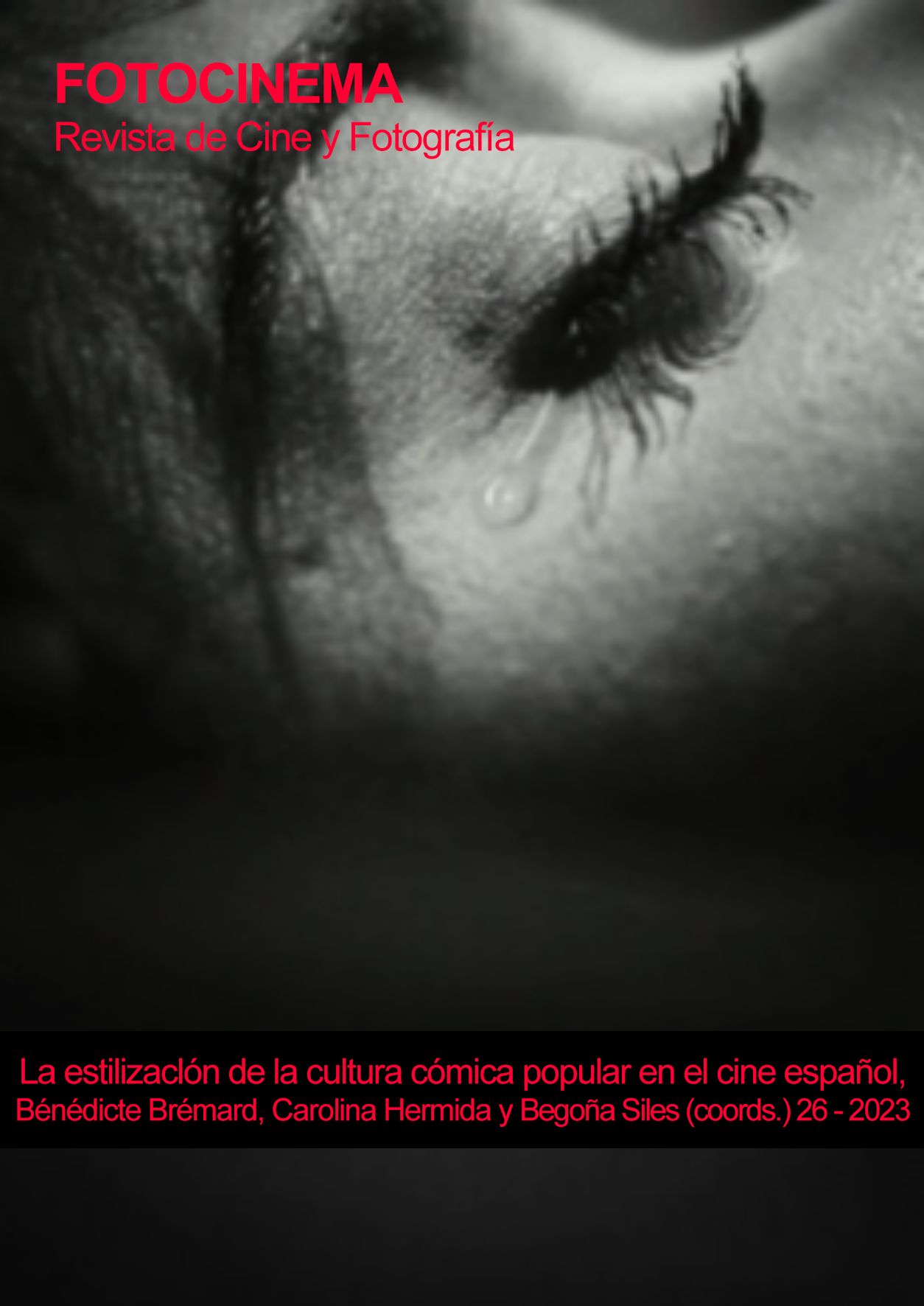El extraño viaje (to nowhere) by Fernando Fernán-Gómez
Bakhtin to Camilo José Cela via Baudelaire and Valle-Inclán
DOI:
https://doi.org/10.24310/Fotocinema.2023.vi26.15319Keywords:
Spanish Cinema, Bakhtin, Esperpento, Black Humor, Canival, GrotesqueAbstract
El extraño viaje (1964) by Fernando Fernán-Gómez is an exceptional example within that fertile current of Spanish cinema that prolongs a cultural tradition that is deeply rooted among us, for which esperpento and black humor are key notions. But besides being a very worthy heir to that grotesque side of Spanish popular culture cultivated, among others, by authors like Quevedo, Arniches and Valle-Inclán or painters like Goya and Solana, Fernán-Gómez's film is also a work crossed by foreign influences, Alfred Hitchcock's cinema being one of the most productive. In order to clarify to what extent El extraño viaje prolongs this tradition of the grotesque esperpento while at the same time allowing itself to be contaminated by contemporary cinema from abroad, this article analyzes the film in detail in the light of a series of notions coined by Mijail Bakhtin (dialogism, chronotope, carnivalesque, refiguration or ambivalent laughter) and the ideas of other authors who have reflected on the special predilection of the Spanish people for a certain type of humor, such as Camilo José Cela, Charles Baudelaire or Valle-Inclán himself
Downloads
Metrics
Publication Facts
Reviewer profiles N/A
Author statements
Indexed in
-
—
- Academic society
- N/A
- Publisher
- Universidad de Málaga
References
Bajtín, M. (1974). La cultura popular en la Edad Media y en el Renacimiento. El contexto de François Rabelais. Barral Editores, Barcelona (edición original 1965).
Bajtín, M. (1978). Esthétique et théorie du roman. Gallimard (edición original 1975).
Bajtín, M. (1986). Problemas de la poética de Dostoievski. Fondo de Cultura Económica (primera edición en ruso en 1929; edición ampliada y definitiva en 1963).
Baudelaire, Ch. (1976a). De l’essence du rire et généralement du comique dans les arts plastiques. En Oeuvres complètes, vol. II. Gallimard (La Pléiade), p. 538.
Baudelaire, Ch. (1976b). Quelques caricaturistes étrangers. En Oeuvres complètes, vol. II. Gallimard (La Pléiade), pp. 569-570.
Beltrame, F. (1996). Teoria del grotesco. Ed. Della Laguna.
Benjamin, W. (1973). Discursos interrumpidos I. Taurus.
Castro de Paz, J. L. (2010). Fernando Fernán-Gómez. Cátedra.
Cela, C. J. (1994). El gallego y su cuadrilla. RBA Editores (edición original 1949).
Cueto, R. (ed.) (2010). El extraño viaje de Fernando Fernán Gómez. Ediciones de la Filmoteca.
De Regoyos, D. & Verhaeren, E. (2004). España negra. El Tilo (edición original 1899).
F. Heredero, C. (2008). Pedro Beltrán. La humanidad del esperpento. Filmoteca Regional Francisco Rabal.
González García, Á. (1998). José Gutiérrez Solana. En F. Calvo Serraller (Ed.), El realismo en el arte contemporáneo: 1900-1950. MAPFRE, pp. 147-165.
Gutiérrez Solana, J. (2000) La España negra. Comares (edición original 1920).
Kristeva, J. (1970). La poétique de Dostoievski. Seuil.
Llinás, F. & Angulo, J. (eds.) (1993). Fernando Fernán-Gómez. El hombre que quería ser Jackie Cooper. Ayuntamiento de San Sebastián.
Marías, M. (1970). El extraño caso de El extraño viaje, Nuestro Cine, 94, 54-56.
Muñoz Suay, R. (1998). Columnas de cine. Ediciones Filmoteca.
Salinas, P. (1970). Significación del esperpento o Valle-Inclán, hijo pródigo del 98. En Literatura española siglo XX. Alianza Editorial, pp. 86-114 (edición original 1941).
Sklovski, V. (1975). François Rabelais y el libro de M. Bajtín. En La cuerda del arco. Planeta, pp. 241-279.
Téllez, J. L. (1997). El extraño viaje. En J. Pérez Perucha (ed.), Antología crítica del cine español. Cátedra / Filmoteca Española, pp. 585-587.
Todorov, T. (1979). Bakhtine et l’alterité. Poétique, 40, 502-513.
Todorov, T. (1981). Mikhaïl Bakhtine et le principe dialogique, suivi de Écrits du Cercle de Bakhtine. París: Seuil.
Valle-Inclán, R. M. (1994). Entrevistas. Ediciones Pre-Textos.
VV. AA. (1985). Fernando Fernán Gómez. Acteur, réalisateur et écrivain espagnol. Presses Universitaires de Bordeaux.
Downloads
Published
How to Cite
Issue
Section
License
All contents published in Fotocinema Revista científica de cine y fotografía are protected under the Creative Commons Attribution-NonCommercial-ShareAlike 4.0 International (CC BY-NC-SA 4.0) license. All about this license is available in the following link: <http://creativecommons.org/licenses/by-nc-sa/4.0>
Users can copy, use, redistribute, share and exhibit publicly as long as:
- The original source and authorship of the material are cited (Journal, Publisher and URL of the work).
- It is not used for comercial purposes.
- The existence of the license and its especifications are mentioned.
There are two sets of authors’ rights: moral and property rights. Moral rights are perpetual prerogatives, unrenounceable, not-transferable, unalienable, imprescriptible and inembargable. According to authors’ rights legislation, Fotocinema. Revista científica de cine y fotografía recognizes and respects authors moral rights, as well as the ownership of property rights, which will be transferred to University of Malaga in open access. The property rights are referred to the benefits that are gained by the use or the dissemination of works. Fotocinema. Revista científica de cine y fotografía is published in an open access form and it is exclusively licenced by any means for doing or authorising distribution, dissemination, reproduction, , adaptation, translation or arrangement of works.
Authors are responsable for obtaining the necessary permission to use copyrighted images.














13.png)



